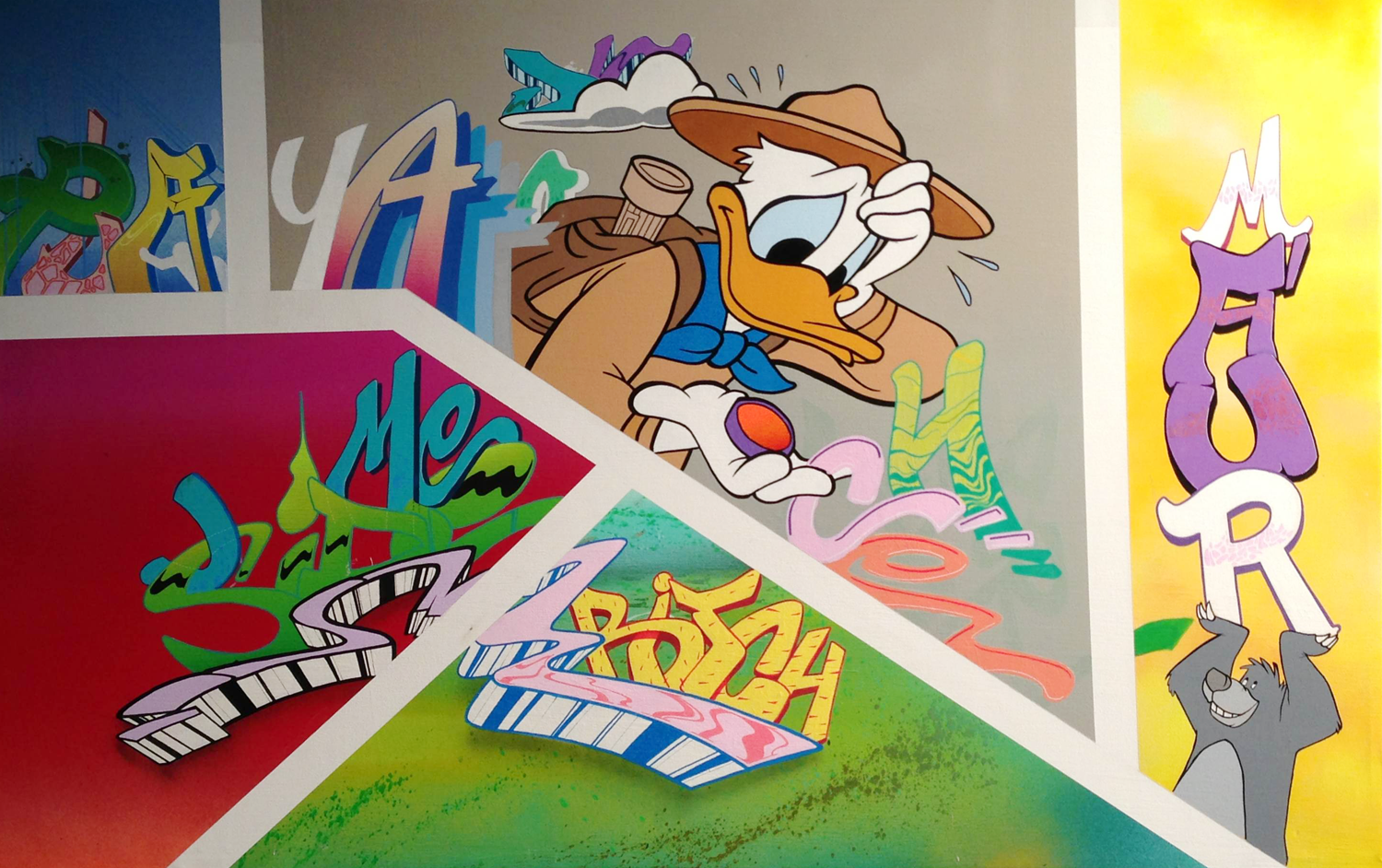
For a stubborn child who couldn’t hold her pencil correctly, walking into an exhibit where the central motif was penmanship paper was like being accosted by a long-forgotten foe. It soon became clear, however, that I had nothing to fear. The gaping exhibition room at Lacuna Artist Lofts in Pilsen pulsated with the beats of DJ Chuck Inglish. Upon walking in, I was greeted by a large white wall overlaid with three sets of solid red and blue lines, the spaces between them bisected by dotted blue lines. This was a painted facsimile of penmanship paper, adorned with huge block letters that spelled out “TYCONS” and “feat MAURICIO RAMIREZ” and, below, the words “Art Exhibit” in elementary school-style cursive.
This image of penmanship paper appears in many of the featured pieces, either woven into the amalgam of neon images in each painting or in the background. One piece includes the classic white, red, and blue paper painted messily onto the side of a freight container. Spray-painted typographic and graffiti-style letters in neon hues hang in front of the container, casting shadows of nonsense poetry over the lines. Most of the time, the artist uses the lines to guide his signature, a perfectly block-lettered MAURICIO RAMIREZ.
Paintings in the gallery are divided into distinct, physically separated categories: paintings with white backgrounds and brightly colored lettering and icons, paintings that incorporate these elements in addition to grayscale and shades of black and white, images rendered in shades of a single color, and a set of works that utilize crisp white lines to make the canvasses look like comic strips.
The exhibit is youthful, designed to evoke memories of grade school. Clusters of lockers serve as makeshift walls, supporting hung artworks and delineating different areas of the room. In the back of the space, visitors compete in a beanbag toss where both the platforms and beanbags display the “TYCONS” logo: graffiti-style lettering of the word where the T wears an Adidas sneaker, the O is replaced by a pixelated Super Mario ghost, and the S is a snake from the Jungle Book.
“TYCONS” is a combination of the words typography and iconography, two forms of visual expression that Ramirez aims to reinvent by giving them a youthful, urban twist. Mauricio’s iconography of choice includes widely recognizable cartoon and video game characters, and his typography combines graffiti with oft-used typefaces and handwritten script. In many of his works, Disney characters smile out from behind the curved and jagged edges of stylized letters that appear ready to burst due to their vivid coloration and simulated depth. Ramirez’s use of graffiti has its origins in his own upbringing: on his website, he writes that much of his early artistic training consisted of copying the sketches and gang symbols his older cousins drew.
Adult attendees recaptured a childlike sense of wonder and excitement through these paintings. People studied them, trying to decipher the words spelled out by the letters (though few of the paintings actually featured recognizable words) or straining to pick out pop-culture figures of their youth from amidst the fray like a grown-up version of “I Spy.” When viewers spotted a familiar figure, their eyes lit up and they called excitedly to their friends to share their discoveries.
However, the exhibit was not simply a way for viewers to relive the days of their youth. One painting, in fact, was decidedly dark: it was an impeccable rendering of Donald Duck and Baloo from “The Jungle Book” in front of a gradient background and sequences of stylized letters that exclaimed, “PLAYA,” “BITCH,” and “ME SIDE.” It was only upon realizing what the letters spelled that I noticed the concerned look on Donald’s face. Going through the gallery again, I began to notice pocket knives tucked into the socks of the Samba-clad feet in most of Ramirez’s works, as well as the plaintive graffiti on the walls of the venue that reads “ALL YOU SEE IS CRIME IN THE CITY.”
Ramirez made “TYCONS” both to celebrate the spirit of youthfulness and to highlight the undercurrents of danger, fear, and repression that accompany youth education, particularly in urban environments. School is not the place that it once was: fraught with teacher strikes, standardized testing, and school shootings, childhood is, quite literally, not all fun and games. By transgressing the boundaries of lined paper through a new kind of writing—these free-form, brightly colored ABC’s that feature heavily in his works—Ramirez fights back against this new age of education.
